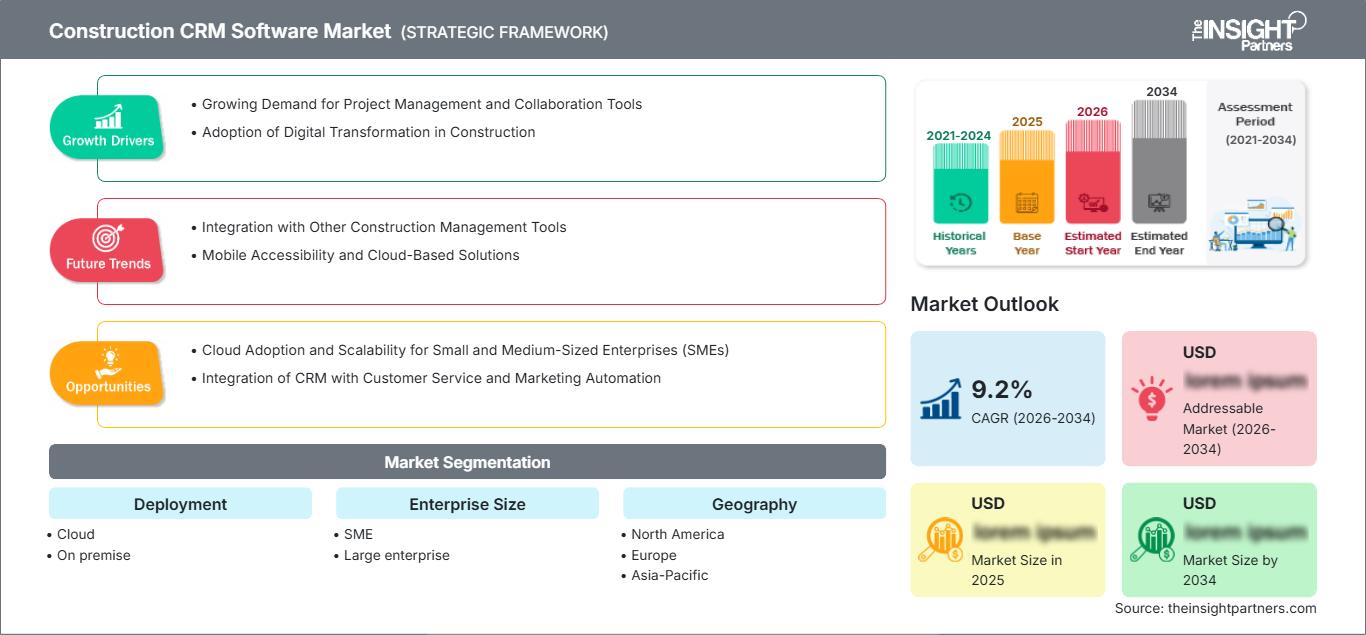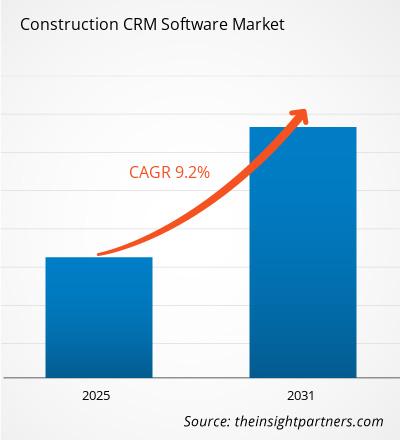Si prevede che il mercato dei software CRM per l'edilizia crescerà a un CAGR del 9,2% dal 2026 al 2034. Le condizioni di mercato continuano a evolversi, aprendo nuove opportunità per gli stakeholder. Il panorama generale riflette un progresso stabile e un potenziale di crescita a lungo termine.
Il rapporto è segmentato per implementazione (Cloud, On-premise); dimensione aziendale (PMI, grandi imprese). L'analisi globale è ulteriormente suddivisa a livello regionale e per i principali paesi. Il rapporto offre il valore in USD per l'analisi e i segmenti sopra indicati.
Scopo del rapporto
Il rapporto "Construction CRM Software Market" di The Insight Partners mira a descrivere il panorama attuale e la crescita futura, i principali fattori trainanti, le sfide e le opportunità. Ciò fornirà approfondimenti a vari stakeholder aziendali, come:
- Fornitori/produttori di tecnologia: per comprendere le dinamiche di mercato in evoluzione e conoscere le potenziali opportunità di crescita, consentendo loro di prendere decisioni strategiche informate.
- Investitori: per condurre un'analisi completa delle tendenze in merito al tasso di crescita del mercato, alle proiezioni finanziarie di mercato e alle opportunità esistenti lungo la catena del valore.
- Organismi di regolamentazione: per regolamentare le politiche e le attività di polizia nel mercato con l'obiettivo di ridurre al minimo gli abusi, preservare la fiducia degli investitori e sostenere l'integrità e la stabilità del mercato.
Segmentazione del mercato del software CRM per l'edilizia
- Cloud
- On premise
Dimensioni aziendali
- PMI
- Grande impresa
Potrai personalizzare gratuitamente qualsiasi rapporto, comprese parti di questo rapporto, o analisi a livello di paese, pacchetto dati Excel, oltre a usufruire di grandi offerte e sconti per start-up e università
Mercato del software CRM per l'edilizia: Approfondimenti strategici

-
Ottieni le principali tendenze chiave del mercato di questo rapporto.Questo campione GRATUITO includerà l'analisi dei dati, che vanno dalle tendenze di mercato alle stime e alle previsioni.
Fattori di crescita del mercato dei software CRM per l'edilizia
- Crescente domanda di strumenti di gestione progetti e collaborazione: con la crescente complessità dei progetti edili, cresce la necessità di soluzioni di gestione progetti affidabili. I software CRM per l'edilizia aiutano a semplificare la comunicazione, gestire i flussi di lavoro, monitorare l'avanzamento dei progetti e collaborare tra team, appaltatori e clienti. Ciò aumenta l'efficienza operativa, riduce gli errori e garantisce il rispetto delle scadenze, alimentando la domanda di tali software nel settore edile.
- Adozione della trasformazione digitale nell'edilizia: il settore edile sta adottando sempre più strumenti digitali per migliorare la produttività e ridurre al minimo le inefficienze. I software CRM su misura per il settore edile consentono una migliore gestione delle relazioni con i clienti, dei lead e delle vendite, fornendo al contempo analisi e approfondimenti per migliorare il processo decisionale. Questa tendenza alla digitalizzazione è un fattore chiave per la crescita del software CRM per l'edilizia.
Tendenze future del mercato dei software CRM per l'edilizia
- Integrazione con altri strumenti di gestione dell'edilizia: il software CRM per l'edilizia viene sempre più integrato con altre soluzioni specializzate per la gestione dell'edilizia, come software di project management, budgeting e contabilità. Questo crea una piattaforma unificata che semplifica i processi nelle varie fasi dei progetti di costruzione, fornendo dati in tempo reale e garantendo una comunicazione fluida tra tutte le parti interessate.
- Accessibilità mobile e soluzioni basate su cloud: con un numero crescente di team di costruzione che lavorano in cantiere, cresce la domanda di soluzioni CRM ottimizzate per i dispositivi mobili e basate su cloud. Queste soluzioni consentono ai team di accedere ai dati dei clienti, ai dettagli dei progetti e ai report da qualsiasi luogo, migliorando la comunicazione, la collaborazione e la reattività, garantendo al contempo l'archiviazione sicura e la facile accessibilità dei dati.
Opportunità di mercato per i software CRM nel settore edile
- Adozione del cloud e scalabilità per le piccole e medie imprese (PMI): il settore edile si sta orientando sempre più verso soluzioni basate sul cloud per la loro flessibilità, scalabilità e convenienza. Esiste una significativa opportunità di sviluppare soluzioni software CRM convenienti e scalabili specificamente per le piccole e medie imprese (PMI). Queste soluzioni possono fornire alle PMI lo stesso livello di gestione delle relazioni con i clienti, monitoraggio dei progetti e business intelligence delle aziende più grandi, livellando il campo di gioco e consentendo alle PMI di competere in modo più efficace sul mercato.
- Integrazione del CRM con il servizio clienti e l'automazione del marketing: con l'aumento delle aspettative dei clienti, il settore edile sta ponendo maggiore enfasi sulla fornitura di servizi eccezionali ed esperienze personalizzate. Un software CRM che si integra con le piattaforme di servizio clienti e gli strumenti di automazione del marketing può offrire alle aziende edili un approccio completo al coinvolgimento dei clienti. Questa integrazione consente alle aziende di automatizzare le campagne di marketing, monitorare le interazioni con i clienti e personalizzare le comunicazioni, migliorando la fidelizzazione, la fidelizzazione e la generazione di lead. Le aziende che offrono soluzioni CRM integrate di questo tipo saranno ben posizionate per capitalizzare sulla crescente domanda di coinvolgimento personalizzato dei clienti.
Mercato del software CRM per l'edilizia
Le tendenze regionali e i fattori che influenzano il mercato dei software CRM per l'edilizia durante il periodo di previsione sono stati ampiamente spiegati dagli analisti di The Insight Partners. Questa sezione illustra anche i segmenti di mercato e la geografia della gestione delle malattie del ritmo cardiaco in Nord America, Europa, Asia-Pacifico, Medio Oriente e Africa, America meridionale e centrale.
Mercato del software CRM per l'edilizia Report Scope
| Attributo del rapporto | Dettagli |
|---|---|
| Dimensioni del mercato in 2025 | US$ XX Million |
| Dimensioni del mercato per 2034 | US$ XX Million |
| CAGR globale (2026 - 2034) | 9.2% |
| Dati storici | 2021-2024 |
| Periodo di previsione | 2026-2034 |
| Segmenti coperti |
By Distribuzione
|
| Regioni e paesi coperti |
Nord America
|
| Leader di mercato e profili aziendali chiave |
|
Densità degli operatori del mercato del software CRM per l'edilizia: comprendere il suo impatto sulle dinamiche aziendali
Il mercato dei software CRM per l'edilizia è in rapida crescita, trainato dalla crescente domanda degli utenti finali, dovuta a fattori quali l'evoluzione delle preferenze dei consumatori, i progressi tecnologici e una maggiore consapevolezza dei vantaggi del prodotto. Con l'aumento della domanda, le aziende stanno ampliando la propria offerta, innovando per soddisfare le esigenze dei consumatori e sfruttando le tendenze emergenti, alimentando ulteriormente la crescita del mercato.

- Ottieni il Mercato del software CRM per l'edilizia Panoramica dei principali attori chiave
Punti di forza
- Copertura completa: il rapporto analizza in modo esaustivo prodotti, servizi, tipologie e utenti finali del mercato dei software CRM per l'edilizia, offrendo una panoramica olistica.
- Analisi degli esperti: il rapporto è redatto sulla base della conoscenza approfondita di esperti e analisti del settore.
- Informazioni aggiornate: il rapporto garantisce la pertinenza aziendale grazie alla copertura di informazioni e tendenze dei dati recenti.
- Opzioni di personalizzazione: questo rapporto può essere personalizzato per soddisfare le esigenze specifiche del cliente e adattarsi in modo appropriato alle strategie aziendali.
Il rapporto di ricerca sul mercato dei software CRM per l'edilizia può quindi contribuire a guidare il percorso di decodificazione e comprensione dello scenario del settore e delle prospettive di crescita. Sebbene possano esserci alcune valide preoccupazioni, i vantaggi complessivi di questo rapporto tendono a superare gli svantaggi.
- Analisi storica (2 anni), anno base, previsione (7 anni) con CAGR
- Analisi PEST e SWOT
- Valore/volume delle dimensioni del mercato - Globale, Regionale, Nazionale
- Industria e panorama competitivo
- Set di dati Excel
Report recenti
Rapporti correlati
Testimonianze
Motivo dell'acquisto
- Processo decisionale informato
- Comprensione delle dinamiche di mercato
- Analisi competitiva
- Analisi dei clienti
- Previsioni di mercato
- Mitigazione del rischio
- Pianificazione strategica
- Giustificazione degli investimenti
- Identificazione dei mercati emergenti
- Miglioramento delle strategie di marketing
- Aumento dell'efficienza operativa
- Allineamento alle tendenze normative






















 Ottieni un campione gratuito per - Mercato del software CRM per l'edilizia
Ottieni un campione gratuito per - Mercato del software CRM per l'edilizia